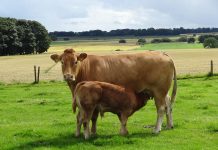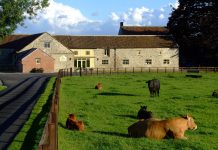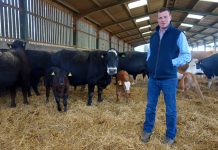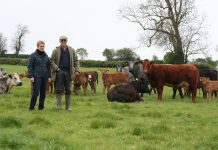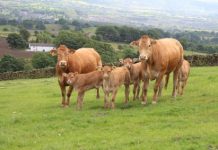The 2016 National Limousin Show is set to be a fantastic showcase of the best in the breed, and taking the helm in the judging ring on 29th July at Carlisle, will be Bruce Goldie, of the Goldies herd in Mouswald, near Dumfries.
Well known for producing top price bulls and females throughout the years, Bruce’s association with the Limousin breed dates back to 1978, when the family herd was first established. Despite the devastating loss of their animals in the 2001 foot and mouth cull, their enthusiasm was such that they spent several years successfully restocking the herd, with carefully selected bloodlines.
Now, the Limousin herd consists of 70 breeding females (10 of which are black and polled), which Bruce runs alongside some commercial heifers used as ET recipients, and a flock of 80 pedigree Texel ewes. Based at the 390-acre farm, Townfoot, Mouswald, with wife Linda and their children Thomas (7) and Isla (5), Bruce is ably supported by his parents Jim and Kay, and stocksman Stuart Kirk.“We were very fortunate to have two farms, two breeds of cattle and two breeds of sheep, so were able to amicably divide up the farming enterprise between my brother Hamish, and I, in 2007. Hamish took on the pedigree Charolais herd and Lleyn flock and is based two miles away, at South Bowerhouses. We both have similar breeding strategies – aiming for quality and high health – but using different breeds, so we still help each other out at sales,” explains Bruce.
Prior to foot and mouth, the Goldies purchased almost all their stock bulls from France – a strategy which had brought them plenty success. Lascard and Epatant were two that bred particularly well, with Epatant being the first Limousin bull to breed two sons at five-figure prices.
“When it came to restocking, we went back to France and bought mainly embryos, which was a slow way of building the herd back up, but we felt it was the best way of getting a good, solid female foundation. There was one cow that we got embryos from which stood out as the best – Emue – a class act, which made a lasting impression on the herd. We eventually bought her when she was 15,” says Bruce. Emue’s grand-daughters and great grand-daughters are herd favourites today, and her bull progeny includes Goldies Terence (retained as a herd sire, breeding bulls to 20,000gns), and Goldies Tony (Carlisle champion which sold for 16,000gns). The full sister of those two bulls, Goldies Tiffany, is the dam of one of the herd’s most successful breeding females, Goldies Vitality. She was flushed extensively due to her ability to ‘click’ with various bulls, and bred several five-figure priced animals.
“Vitality was the dam of Goldies Comet, which bred the 125,000gns record price heifer, Glenrock Illusion, and she also produced the 26,000gns Goldies Classic, the 21,000gns Goldies Goldfinger and a £20,000 heifer,” says Bruce.
“Vitality, along with a couple of daughters and grand-daughters, now make up the flushing team, and the line has been such a success that we’ve recently retained a grandson, Goldies Juggler. His dam, Fairytale is our best breeding cow at the moment and we think his full sister is the best heifer we’ve ever bred,” he adds.
Another daughter of Emue worth a mention is Goldies Beauty – dam of the 22,000gns Carlisle champion, Goldies Fandango; the retained successful stock bull Goldies Fortress (sire of bulls to 20,000gns); and the heifer, Goldies Imagination, which sold for 12,000gns at six months old.
The herd also holds the record for the top price black Limousin, with Goldies Black Forever making 30,000gns at Carlisle in 2012. He goes back to an impressive cow, Dutchess Olivia, which has produced another successful breeding line at Townfoot.
Bruce says he always has the commercial man in mind, and when selecting bulls to use, he looks for growth, length and muscle, but they must be correct too. He also puts high emphasis health, with the herd being accredited free of BVD and Johnes (risk level 1). Current stock bulls include the home-bred Goldies Fortress, jointly owned with the Marlepark herd; the young bull, Goldies Juggler, and Foxhillfarm Irish Lad, which was bought in partnership with Jonathan Watson for 38,000gns.
“Irish Lad’s first crop are on the ground now and are looking very promising. Stock bulls must have sound commercial traits, but they need character as well and we take performance figures into consideration too. An important factor is that they must have outstanding dams and grand-dams, which our current stock bulls do have,” explains Bruce, who has enjoyed a particularly good year on the sales front, securing the top pen average at the last three Stirling sales, from May 2015 to February 2016.
Furthermore, at Carlisle in October, 2015, he sold five bulls to average £12,075, and at the same venue in February this year, he had two 14,000gns sellers, Goldies Jazz and Goldies Joker.
With the female numbers now at an ideal level for the farm, Bruce is now able to hold an annual female sale of 20-25 head, at Carlisle, which has proved successful so far. In fact, two recent Carlisle junior champions, Tweeddale Goldie and Roxburgh Gurka, were bought inutero in Goldies females.
“With the fertility, productivity and longevity of the Limousin, coupled with our herd policy of calving younger than some breeders, it means we don’t need to keep many females to maintain the numbers in the herd,” explains Bruce.
The Limousins are run commercially at Townfoot, and calving takes place throughout the year, to suit the sales in February, May and October. All young females and dry cows are wintered on slats.
“The cows that are suckling are fed silage along with home-grown barley which is treated with Maxammon balancer to increase protein, with the spring calving cows getting 3kg of straw and silage,” says Bruce.
Meanwhile, young bulls graze outside all summer and those destined for the October sales are brought in by September.
“A lot of breeders are now keeping their bulls inside all summer, but we feel that by allowing them to be exposed to worms and husk, and get plenty exercise, then there’s more chance of them doing well and lasting longer for the purchaser. It’s important to us that buyers are happy with their purchases, and we like to sell to regular customers – we’ve sold bulls that have lasted for 15 years on some units.
“When we do bring the bulls in, they are put into courts in batches, so they can still get exercise, and they are fed three times a week with a TMR comprising home-grown forage, straw and cereals, combined with beet pulp and dark grains. This is then molassed and mineralised and fed through a feeder wagon. I think feeding them that way is healthier for them, as they can eat it at their leisure,” says Bruce, who is impressed with the Limousin Society’s use of modern technology to aid the development of the breed.

“I think it is a very progressive society that is always looking for new, innovative ideas. The Limousin is in a strong position – no other breed can sell bulls at so many centres, at all times of year, and maintain such a high average.
“It’s also a society with a great social side to it, which helps boost numbers and enthusiasm at shows up and down the country. I’m sure the 45th anniversary show will be a great spectacle – it’s an honour to be asked to judge it and it’s a job I’m very much looking forward to,” says Bruce, who enjoyed success in the ring at the previous National Show, in 2011.
“We took our then stock bull, Hartlaw Excaliber, which was jointly owned with the Dumbreck herd, and we were delighted when he won the supreme male championship. Other than that, we don’t normally exhibit at the summer shows – just because it doesn’t suit our system at that time of year – but I admire those who do; it’s a great shop window for the breed.
“The Limousin herd is our main business enterprise, but it’s also my main interest and hobby, and I love going to shows and seeing what’s coming on and what’s new. I’m sure I’ll have plenty top quality animals to select from at Carlisle in July!”









